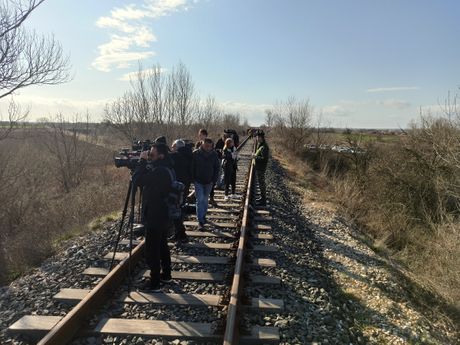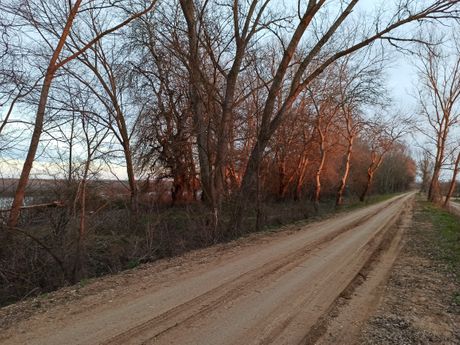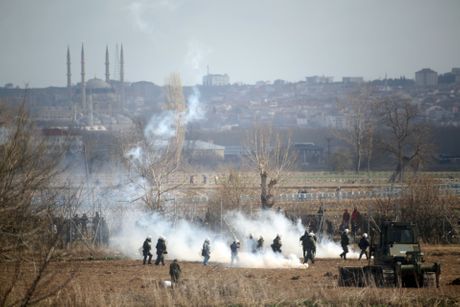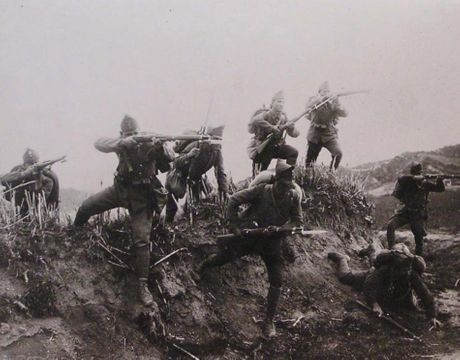Migrants charging, with minefields around: We entered a restricted military zone on the Greek border
"Use the paths we use to reach to our fields. Take care, some parts of the forest have been mined, the entire river bank is closed and there are permanently closed military zones. If Greek patrols stop you, say you got lost," this was the advice we got when we reached Orestiada on Friday, located just 5 kilometers from the the Maritsa River, that forms the natural border between Greece and Turkey.
We listened to it.
The ride to Maritsa itself was riddled with uncertainty.
Local dirt roads are blocked with tree branches that we had trouble bypassing, approaching a wood-covered embankment around which lie minefields. We paused and shot right in front of the mined area, a video you can see at the top of the page - a place few news crews have been able to reach.
Why did the Greeks mine this whole stretch of land?
In the past decades, during tensions with Turkey, minefields were created in places that might represent an easy crossing point for "invasion forces." In order not to harm livestock and local people, these places are fenced off and marked, but passage is difficult and is monitored by military patrols.

Watchtowers and army patrols moving along the river bank arms are noticeable on the Turkish side of the Maritsa. According to the Greeks, people on the Turkish side of the village make less use of its banks.

The migrant crisis has changed the lives of residents on the Greek and Turkish sides of the Maritsa River. In 2012, Greece erected a fence more than 11 kilometers long on the land portion of the border, and also continued to fortify the river banks.
Before the migrant crisis, inhabitants of Orestia, Sakos, Nea Visa, and other villages and towns were free to cross the river and fish or swim there. Yet, even then, some parts were off limits to civilians.

Greeks and Turks - how it all began, and why the Maritsa is important to the Orthodox country
The source of the Maritsa River is in Bulgaria and represents the basin of all rivers of the Thrace geographical region (the area is shared by Bulgaria, Greece and Turkey). Of the 212 kilometers of the Greek-Turkish border in Thrace, the river runs along 201. Although not navigable, Maritsa is a large river. In some parts, it can be walked across, in others, it flows rapidly like a mountain streams- in places, the river bed is up to 40 meters deep, so boats can be used there.
So far, migrants have mostly been looking for shallow waters to cross the river on foot, because its strong currents can carry away those attempting to swim across.
Video: Its getting more tense! Shots heard on the Greek side as migrants attempt to cross the border from Turkey
Although Greece and Turkey joined NATO on the same day, February 2, 1952, the hostility between the two countries has been ongoing for hundreds of years. The whole Thrace region belonged to the Ottoman Empire until 1912, and went to Bulgaria after the First Balkan War. After the defeat of Bulgaria and the Ottomans in World War I, Greece gained a part of Thrace and the present border was created. When the Greek-Turkish War of 1919-1922 ended, an agreement on population exchange was signed, thus forming the present states.
Nevertheless, in 1923, the Republic of Turkey invaded the Maritsa River, using the crisis in relations between Greece and the Fascist-ruled Italy.
The normalization of Greek-Turkish relations began in the mid-1950s.
The first border crossing was opened only in 1952, between Kastanies and the Turkish village of Karaagac. The second border crossing was opened south of a bridge over the Maritsa, between Kipoi in Greece and Ibrigtepe in Turkey in 1962. But despite that, whenever relations between the two countries got strained, the border would get further fortified. The military came to power several times in both countries, and these were periods of militarization.

In addition, in 1955, the Turks carried out a massacre of indigenous Greeks in Istanbul when about 30 people were killed and several thousand were brutally beaten in the streets and in their homes.
In the two days of September that year, thousands of Greek homes, cultural centers, stores and churches were destroyed.
The angry mob organized by the Turkish authorities of the time also targeted Jews and Armenians.
The next time the border was established was during the Cyprus crisis and Turkey's invasion of the island.
Video: A Telegraf crew on the Greek-Turkish border: Migrants trying to break through the fence
(telegraf.tv crew)
Video: Gde idu naši sugrađani za Novu godinu: Neko u Milano ili Pariz, neko kod kuće, a neko...
Telegraf.rs zadržava sva prava nad sadržajem. Za preuzimanje sadržaja pogledajte uputstva na stranici Uslovi korišćenja.

